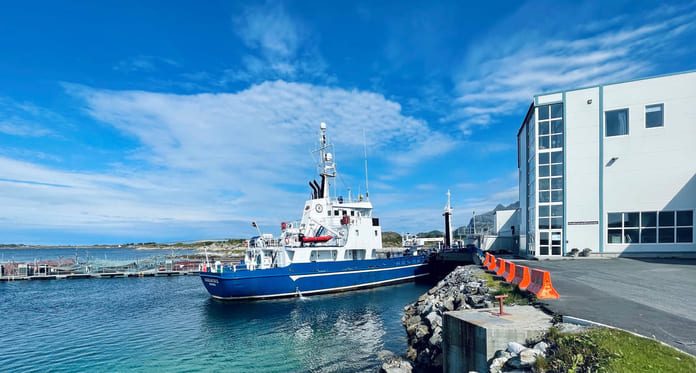There has been an unusually slow financial reporting this year, and all the annual accounts for the fish farming companies are still reached Brønnøysund, the tiny town in the north of the country where the annual reports are registered. But the trend is clear: In terms of profitability, measured in operating margin, last year was the weakest in the aquaculture industry in eight years.
The large farmers’ operating margin ended at an average of 15 per cent, which is a significant fall from 21.9 per cent in 2019.
An important and imminent explanation is the salmon price, which weakened by 5.7 per cent from 2019 to 2020. Subdued demand, as a function of the corona pandemic, must bear a good part of the blame for this.
The salmon price has also strengthened somewhat so far in 2021.
Inlaid cost base
Rising feed costs, but also capital-intensive lice control and disease control, contributed to increased production costs for farmers.

For western fish farmers, the authorities’ biomass reductions in PO4 and PO5 also supplemented the results. On a national basis, however, the farmers’ total slaughter volume of salmon increased by 1.3 per cent from 2019 to 2020.

Dominated
In terms of sales, the country’s largest farmers of salmon and trout are still dominated by the listed triumvirate of Mowi, Lerøy and SalMar. These three sold fish for NOK 70.5 billion (€7 billion) last year.

If you look at the operating results over a longer period of time, there are clear differences between the farmers. Some deliver consistently better results than others. Likewise, there are some which are generally weaker than comparable companies.
Also read: No fish farmer get the margins wellboat owners do
Of the 20 largest Norwegian fish farmers, Eidsfjord Sjøfarm, with an average operating margin of 38.2 per cent, has performed the strongest in the five-year period 2016 to 2020.
In the places after the Sortland company follows another Nordland fish farmer, namely Nova Sea (34.7 per cent) and Central Norwegian Salmonor (5.1 per cent). It should also be mentioned here that Salmonor’s 2020 result has not yet been published – but it will hardly increase the average.
Of the listed fish farmers, SalMar excels, with an operating margin of 29.3 per cent in the last five years.
| 2016 | 2017 | 2018 | 2019 | 2020 | Average last five years | |
| Nova Sea | 37.7% | 37.8% | 36.0% | 34.6% | 27.5% | 34.7% |
| Firda Seafood Group | 34.5% | 27.6% | 24.1% | 14.9% | 25.3% | |
| SalMar | 34.2% | 26.0% | 38.1% | 24.8% | 23.3% | 29.3% |
| Emilsen Fisk | 15.8% | 19.9% | 11.4% | 29.1% | 16.7% | 18.6% |
| Alsaker | 39.9% | 35.0% | 34.1% | 32.9% | 27.6% | 33.9% |
| Nordlaks | 40.6% | 43.0% | 38.5% | 27.7% | 21.5% | 34.3% |
| Ellingsen Seafood | 38.2% | 40.8% | 41.2% | 37.6% | 14.5% | 34.4% |
| Bremnes Seashore | 14.0% | 18.0% | 9.9% | 9.5% | 6.0% | 11.5% |
| Lingalaks | 33.6% | 24.9% | 17.9% | 10.3% | -3.3% | 16.7% |
| Central Norwegian Aquaculture | 26.6% | 37.8% | 28.4% | 33.0% | 18.7% | 28.9% |
| SinkaBerg-Hansen | 21.8% | 5.3% | 11.2% | 17.6% | 12.8% | 13.7% |
| Lerøy Seafood Group | 16.5% | 10.7% | 21.7% | 13.4% | 9.8% | 14.4% |
| Cermaq | 3.7% | 26.0% | 19.6% | 16.4% | ||
| Mowi | 28.2% | 13.4% | 24.7% | 17.4% | 4.9% | 17.7% |
| Grieg Seafood | 23.6% | 11.7% | 17.3% | 10.4% | 5.3% | 13.7% |
| Norway Royal Salmon | 20.7% | 1.9% | 15.9% | 7.6% | 2.1% | 9.6% |
| Eidsfjord Sjøfarm | 45.7% | 44.2% | 40.0% | 32.8% | 28.1% | 38.2% |
| Måsøval Fish farming | 5.1% | 14.4% | 25.3% | 20.8% | 24.9% | 18.1% |
| Salmonor | 28.5% | 41.6% | 34.6% | 35.5% | 35.1% | |
| Erko Seafood | 32.9% | 20.2% | 24.3% | 5.2% | 20.6% |

